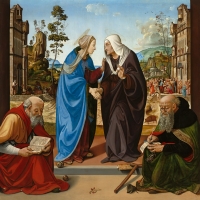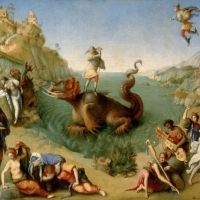Among the most inventive painters of the Italian Renaissance, Piero di Cosimo was celebrated by his early biographer Giorgio Vasari for “the strangeness of his brain, and his constant seeking after difficulties.” In altarpieces, poetic mythologies, portraits, and festival designs, the artist gave life to distinctive characters endowed with poignant emotion and memorable individuality. Piero’s compositions are best known for their imaginative detail, but he also merits appreciation as a vivid narrator of ancient legends and a creator of evocative landscape backgrounds. For centuries, the artist enjoyed a reputation as an eccentric, so devoted to the secrets of art and nature that he abandoned human company and lived a meager existence. In recent decades, however, new insights and discoveries have transformed our understanding of the master’s career and legacy. Contrary to the myth of the solitary madman, Piero was a successful and sought-after painter.
- Piero di Cosimo
- Italian, 1462 - 1522
- Piero di Cosimo
- Allegory
- probably c. 1500
- Piero di Cosimo
- The Nativity with the Infant Saint John
- c. 1495/1505
Piero di Cosimo: A Closer Look

View details of
The Visitation with Saints Nicholas and Anthony Abbot

View details of
Liberation of Andromeda
The two works considered here exemplify Piero’s mastery of sacred history and classical myth, diverse fields that were undergoing a profound revolution in Renaissance Florence. The Visitation with Saints Nicholas and Anthony Abbot influenced the growth of the monumental narrative altarpiece in the artist’s native city, while Liberation of Andromeda marked the culmination of a local genre of domestic paintings recounting the exploits of ancient gods and heroes.
Banner Image: Piero di Cosimo, Vulcan and Aeolus, late 1480s, oil and tempera on canvas, National Gallery of Canada, Ottawa, © National Gallery of Canada
